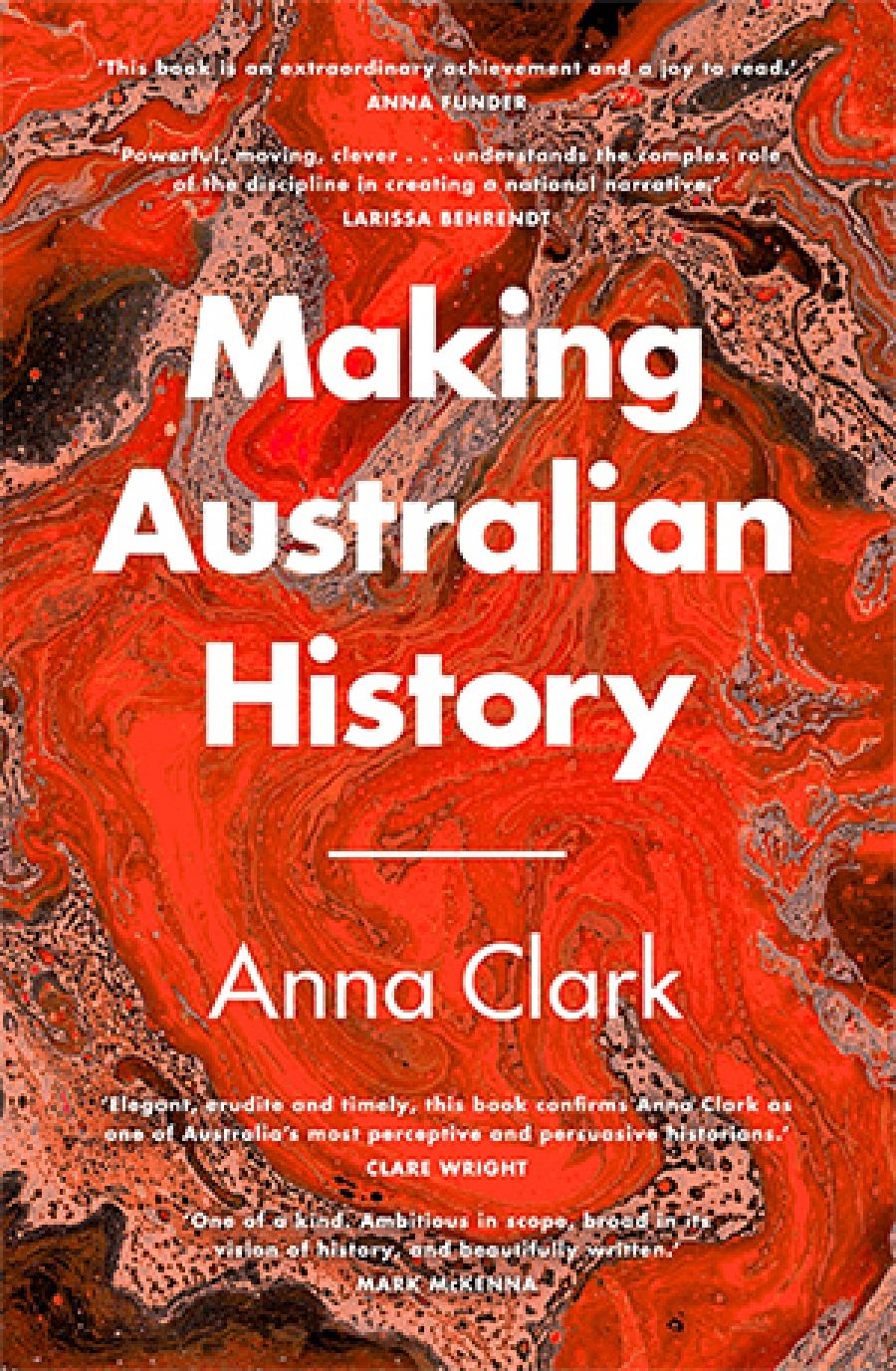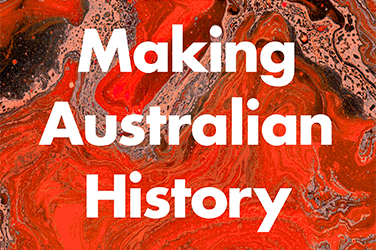
- Free Article: No
- Contents Category: History
- Review Article: Yes
- Article Title: Memory. Silence. Time.
- Article Subtitle: A puzzling, provocative look at historiography
- Online Only: No
- Custom Highlight Text:
There are many ways one might write a history of Australian history, but from any angle it’s a heroic project. In Making Australian History, Anna Clark is open about the difficulties, the possibilities, and her choices. How do you make sense of Australian history, she asks, amid a ‘swirl of changing sensibilities, methods, culture, politics and place’? How do you trace the story of a discipline across time, when each generation has defined the contours and boundaries of that discipline differently? How do you write a genuinely inclusive history of Australian History – one that gives due place to the full range of historical forms, not just those approved in academic circles?
- Featured Image (400px * 250px):

- Alt Tag (Featured Image): Penny Russell reviews 'Making Australian History' by Anna Clark
- Book 1 Title: Making Australian History
- Book 1 Biblio: Vintage, $34.99 pb, 429 pp
Behind these questions lurks the one raised by the book’s title: what does it mean to ‘make’ history? Clark uses the idea of ‘history-making’ to capture practices that ‘sit outside the formal discipline but have nevertheless had an impact on it’. While acknowledging that there are real challenges to making the discipline itself more inclusive, Clark insists that this is still a conversation historians should have. We must, she suggests, recognise ‘the potential of diverse history-making practices and texts to bridge some of the gaps in our historical canon’.
Walking in the Dyarubbin–Hawkesbury region, Clark was struck by the way ‘uneven layers of Aboriginal and colonial history overlap’ in the landscape. She was moved to ponder forms of history-making that predated the Western discipline of history by many thousands of years. And she was driven to rethink the structure of the book she was writing, to ‘break out’ from a conventional narrative form and adopt instead what she describes as a ‘ponderous (but I hope not circuitous)’ analysis of the ‘structure, functions and ethics of the discipline itself’.
The book, while certainly filled with ponderings, is far from ponderous. Clark’s writing is lucid, engaging, open, and unpretentious. The book, she hopes, will be a ‘discussion starter’; it is not intended as the final word. Threaded throughout are echoes of conversations Clark has held over many years: with herself; with colleagues, peers, and mentors; and with some of the historians whose work she reflects on in the book. (Perhaps this is in itself an illustration of how history is ‘made’.) Her reflections unroll in unexpected directions: always thoughtful, sometimes quirky, often provocative, occasionally profound.
Though not circuitous, the structure is certainly not linear. Each chapter is built around a specified ‘text’ that serves as an object for examination and explication. Some of the selected texts are conventional products of the discipline – school textbooks or academic treatises. There is no suggestion, however, that they hold an especially privileged place in the canon of Australian history, or in the book itself. Each has been chosen only as the starting point for treatment of an evocative theme. Each chapter weaves across, through, and beyond the text to discourse upon the larger issue. Nation. Gender. Country. These chapters sit, on equal terms, with others built on different forms of history-making: the Australian War Memorial, a convict ballad, an anguished reappraisal of a pioneering family’s history, a celebrated lecture, a heated radio debate. More striking still are the alternative, subversive histories created by Indigenous Australians: rock art recording the arrival of the first white ships, fish traps of ancient date and ongoing historical significance, the first ‘Day of Mourning’ in 1938, a poem that wrestles with the weight of the recorded and unrecorded past. Each text opens a new theme for reflection. Memory. Imagination. Silence. Time.
Some texts are familiar, others surprising and fresh; together, they allow Clark to cover a good deal of territory. In a book of such range, it is unsurprising that the quality of discussion should be uneven (she’s confident on memory, conscientious on contact, predictable on convicts, perceptive on nation and protest, provocative on colour, puzzling on gender). Inevitably there are gaps, perhaps the most notable being the near absence of any discussion of class or labour history. Times have changed.
It’s a horizontal, democratic structure. The innovative form opens possibilities for thinking about history and history-making in expansive, non-prescriptive ways. But the looseness of the form poses some problems, too. While Clark is avowedly eager to promote a conversation, she seems strangely reluctant to set out its grounds, or to choose her own – let alone defend a unifying argument. Openness contributes to ambiguity, perhaps to some unthought-out positions. While advocating the inclusive expansiveness of ‘history-making’, Clark nonetheless retains a capitalised ‘History’ to signify the ‘discipline’ – the subject as taught in schools and universities. For all its democratic appearance, then, the book holds firmly to the notion that a discipline of ‘History’ survives and matters, retaining its power to ‘shape the national story’, make or break careers, and rule upon the legitimacy of different forms of history-making. Clark seeks to put this ‘scholarly’ (ostensibly objective, empirical, evidence-based, analytical) understanding of Australia’s history into conversation with a wider variety of imaginative, commemorative, sentimental, angry, subversive alternatives. The Anzac story may be sentimental, she writes, but it’s ‘also genuine’. Fiction and poetry employ imagination to go to places where disciplinary historical practice cannot; historians should nonetheless heed the moral, ethical, and cultural insights that these works can yield. Indigenous art, oral history, and memory offer stories not verifiable by scientific historical method, but these should not be ignored.
Much of this is incontrovertible. Less clear is where the conversation should go next. Should the discipline of ‘History’ expand its favoured methods to include those of memoir, art, and song – or should the discipline be even more narrowly defined, while ceding authority to these other forms? How should we understand, let alone alter, the place, role, or standing of the discipline in the wider culture of ‘history-making’? Sometimes Clark blurs disciplinary boundaries in the name of inclusiveness; sometimes she reasserts them in the name of engagement. The slipperiness of the ground makes the conversation hard to follow, but I missed any clear defence of critical, sceptical, analytic history as a valuable corrective to propaganda, sentimentality, misrepresentation, or misunderstanding.
I missed, too, any clear delineation of the disciplinary field of ‘Australian History’ today. While acknowledging that its contours and boundaries have shifted over time, Clark refrains from attempting to pin down its present form. Yet her very plea for a more inclusive history evokes the spectre of one that is not so – a ghostly image of authoritative and exclusive national history-making that few historians writing in Australia today would aspire to. I found myself wishing that Clark had done more to represent the multiple possibilities, the richness, the expansiveness, the critical edginess that characterise the best contemporary Australian history writing: cultural, legal, sexual, domestic, industrial, or carceral histories of Australia’s varied communities, for example. I wanted her to turn her eyes away from the glaring light of the national story and to seek richer historical narratives of Australians in the shadows.
But if I sometimes suspected that Clark was artificially prolonging the life of the very problems she aims to critique, such fears do the book less than justice. The elusive shadow arguments are a product of Clark’s deliberate choice to eschew the conventions of scholarly debate and to adopt a horizontal structure and a looping, meditative, discursive style. The issues she raises – both by what she says and what she has chosen to leave out – are of vital and continuing significance. They are not easily resolved, and Clark does not pretend to resolve them. Reading her book, I was in turn engaged, beguiled, puzzled, unconvinced – and provoked, in the best sense of the word. It will take much more than a thousand words to grapple with the teasing, unsettled issues she has raised. Her questions still echo in my head, and I look forward to thrashing them out in future conversations with friends and colleagues. In that sense, this bold, expansive, disarming, baffling book has succeeded in its aims.


Comments powered by CComment